Assessment of Pesticide Content in Apples and Selected Citrus Fruits Subjected to Simple Culinary Processing
Abstract
1. Introduction
2. Materials and Methods
2.1. Experimental Material
2.2. Culinary Processing
- Apples: the test material consisted of whole fruits, unpeeled and unwashed, apple peel and flesh, and also samples of whole apples after simple washing in a stream of cold tap water for 15 s (about 1.5 L/1 fruit, the time of washing under tap water was shorter than in the model experiment [18], which was aimed at reproducing actual conditions of apple washing in households).
- Citrus fruits: the conventional procedure for preparation for consumption was applied, i.e., the test samples consisted of peeled fruits, in this case samples of peel and flesh, without prior washing of the fruits.
2.3. Chemicals
2.4. Preparation of Samples, Analytical Methods and Instrumentation
2.5. Statistical Analysis
3. Results and Discussion
3.1. Pesticide Residues in Apples and Citrus Fruits—Comparison
3.1.1. Apples
3.1.2. Citrus Fruits
3.2. Effect of Peeling on the Content of Pesticides
3.3. Effect of Conventional Washing of Fruits on the Content of Pesticides
4. Conclusions
Supplementary Materials
Author Contributions
Funding
Institutional Review Board Statement
Informed Consent Statement
Data Availability Statement
Conflicts of Interest
References
- Turner, T.; Burri, B. Potential Nutritional Benefits of Current Citrus Consumption. Agriculture 2013, 3, 170–187. [Google Scholar] [CrossRef]
- Lončarić, A.; Matanović, K.; Ferrer, P.; Kovač, T.; Šarkanj, B.; Skendrović Babojelić, M.; Lores, M. Peel of Traditional Apple Varieties as a Great Source of Bioactive Compounds: Extraction by Micro-Matrix Solid-Phase Dispersion. Foods 2020, 9, 80. [Google Scholar] [CrossRef] [PubMed]
- Slavin, J.L.; Lloyd, B. Health Benefits of Fruits and Vegetables. Adv. Nutr. 2012, 3, 506–516. [Google Scholar] [CrossRef]
- Wallace, T.C.; Bailey, R.L.; Blumberg, J.B.; Burton-Freeman, B.; Chen, C.O.; Crowe-White, K.M.; Drewnowski, A.; Hooshmand, S.; Johnson, E.; Lewis, R.; et al. Fruits, vegetables, and health: A comprehensive narrative, umbrella review of the science and recommendations for enhanced public policy to improve intake. Crit. Rev. Food Sci. Nutr. 2020, 60, 2174–2211. [Google Scholar] [CrossRef]
- Park, H.-M.; Heo, J.; Park, Y. Calcium from plant sources is beneficial to lowering the risk of osteoporosis in postmenopausal Korean women. Nutr. Res. 2011, 31, 27–32. [Google Scholar] [CrossRef] [PubMed]
- Williamson, G. Protective effects of fruits and vegetables in the diet. Nutr. Food Sci. 1996, 96, 6–10. [Google Scholar] [CrossRef]
- Celik, F.; Topcu, F. Nutritional risk factors for the development of chronic obstructive pulmonary disease (COPD) in male smokers. Clin. Nutr. 2006, 25, 955–961. [Google Scholar] [CrossRef]
- Payne, M.E.; Steck, S.E.; George, R.R.; Steffens, D.C. Fruit, Vegetable, and Antioxidant Intakes Are Lower in Older Adults with Depression. J. Acad. Nutr. Diet. 2012, 112, 2022–2027. [Google Scholar] [CrossRef]
- Rejman, K.; Górska-Warsewicz, H.; Kaczorowska, J.; Laskowski, W. Nutritional Significance of Fruit and Fruit Products in the Average Polish Diet. Nutrients 2021, 13, 2079. [Google Scholar] [CrossRef]
- Pem, D.; Jeewon, R. Fruit and vegetable intake: Benefits and progress of nutrition education interventions-narrative review article. Iran. J. Public Health 2015, 44, 1309–1321. [Google Scholar]
- Damos, P.; Colomar, L.-A.; Ioriatti, C. Integrated Fruit Production and Pest Management in Europe: The Apple Case Study and How Far We Are from the Original Concept? Insects 2015, 6, 626–657. [Google Scholar] [CrossRef] [PubMed]
- Khan, N.; Yaqub, G.; Hafeez, T.; Tariq, M. Assessment of Health Risk due to Pesticide Residues in Fruits, Vegetables, Soil, and Water. J. Chem. 2020, 2020, 1–7. [Google Scholar] [CrossRef]
- Łozowicka, B.; Kaczyński, P.; Rutkowska, E.; Jankowska, M.; Hrynko, I. Evaluation of pesticide residues in fruit from Poland and health risk assessment. Agric. Sci. 2013, 4, 106–111. [Google Scholar] [CrossRef]
- Kowalska, G.; Kowalski, R. Pestycydy—Zakres i ryzyko stosowania, korzyści i zagrożenia. Praca przeglądowa. Ann. Hortic. 2019, 29, 5–25. [Google Scholar] [CrossRef]
- The European Commission Regulation (EU). No 396/2005 of the European Parliament and of the Council of 23 February 2005 on maximum residue levels of pesticides in or on food and feed of plant and animal origin and amending Council Directive 91/414/EEC. Off. J. Eur. Union 2005, L70, 1–16. [Google Scholar]
- Liang, C.-P.; Sack, C.; McGrath, S.; Cao, Y.; Thompson, C.J.; Robin, L.P. US Food and Drug Administration regulatory pesticide residue monitoring of human foods: 2009–2017. Food Addit. Contam. Part A 2021, 38, 1520–1538. [Google Scholar] [CrossRef]
- Łozowicka, B.; Hrynko, I.; Iwaniuk, P.; Jankowska, M.; Kaczyński, P.; Konecki, R.; Pietraszko, A.; Rusiłowska, J.; Rutkowska, E. Sprawozdanie z Badań Podstawowych Prowadzonych w 2020 Roku na Rzecz Rolnictwa Ekologicznego. Available online: https://www.ior.poznan.pl/plik,3877,sprawozdanie-prof-dr-hab-bozena-lozowicka-pj-re-027-2020-1-pdf.pdf (accessed on 21 December 2021).
- Yang, T.; Doherty, J.; Zhao, B.; Kinchla, A.J.; Clark, J.M.; He, L. Effectiveness of Commercial and Homemade Washing Agents in Removing Pesticide Residues on and in Apples. J. Agric. Food Chem. 2017, 65, 9744–9752. [Google Scholar] [CrossRef]
- Kowalska, G. Pesticide Residues in Some Polish Herbs. Agriculture 2020, 10, 154. [Google Scholar] [CrossRef]
- Kowalska, G.; Pankiewicz, U.; Kowalski, R. Estimation of Pesticide Residues in Selected Products of Plant Origin from Poland with the Use of the HPLC-MS/MS Technique. Agriculture 2020, 10, 192. [Google Scholar] [CrossRef]
- PN-EN 15662 Foods of Plant Origin—Determination of Pesticide Residues Using GC-MS and/or LC-MS/MS Following Acetonitrile Extraction/Partitioning and Cleanup by Dispersive SPE—QuEChERS-Method 2008; The Polish Committee for Standardization: Warsaw, Poland, 2008; pp. 1–81.
- The European Commission Regulation (EU) No 459/2010 of 27 May 2010 amending Annexes II, III and IV to Regulation (EC) No 396/2005 of the European Parliament and of the Council as regards maximum residue levels for certain pesticides in or on certain products. Off. J. Eur. Union 2010, L129, 3–149.
- The European Commission Regulation (EU) 2016/156 of 18 January 2016 amending Annexes II and III to Regulation (EC) No 396/2005 of the European Parliament and of the Council as regards maximum residue levels for boscalid, clothianidin, thiamethoxam, folpet and tolclofo. Off. J. Eur. Union 2016, L31, 1–44.
- The European Commission Regulation (EU) No 559/2011 of 7 June 2011 amending Annexes II and III to Regulation (EC) No 396/2005 of the European Parliament and of the Council as regards maximum residue levels for captan, carbendazim, cyromazine, ethephon, fenamiphos, thi. Off. J. Eur. Union 2011, L152, 1–21.
- The European Commission Regulation (EU) No 839/2008 of 31 July 2008 amending Regulation (EC) No 396/2005 of the European Parliament and of the Council as regards Annexes II, III and IV on maximum residue levels of pesticides in or on certain products. Off. J. Eur. Union 2008, 000.003, 1–245.
- The European Commission Corrigendum to Commission Regulation (EU) 2020/1085 of 23 July 2020 amending Annexes II and V to Regulation (EC) No 396/2005 of the European Parliament and of the Council as regards maximum residue levels for chlorpyrifos and chlorpyrifos-methy. Off. J. Eur. Union 2020, L245, 31–42.
- The European Commission Regulation (EU) 2020/1566 of 27 October 2020 amending Annexes II and III to Regulation (EC) No 396/2005 of the European Parliament and of the Council as regards maximum residue levels for bupirimate, carfentrazone-ethyl, ethirimol, and pyriofen. Off. J. Eur. Union 2020, L358, 30–58.
- The European Commission Regulation (EU) No 441/2012 of 24 May 2012 amending Annexes II and III to Regulation (EC) No 396/2005 of the European Parliament and of the Council as regards maximum residue levels for bifenazate, bifenthrin, boscalid, cadusafos, chlorantranil. Off. J. Eur. Union 2012, L135, 4–56.
- The European Commission Regulation (EU) 2019/552 of 4 April 2019 amending Annexes II and III to Regulation (EC) No 396/2005 of the European Parliament and of the Council as regards maximum residue levels for azoxystrobin, bicyclopyrone, chlormequat, cyprodinil, difeno. Off. J. Eur. Union 2019, L96, 6–49.
- The European Commission Regulation (EU) No 149/2008 of 29 January 2008 amending Regulation (EC) No 396/2005 of the European Parliament and of the Council by establishing Annexes II, III and IV setting maximum residue levels for products covered by Annex I thereto. Off. J. Eur. Union 2008, L58, 1–398.
- The European Commission Regulation (EU) 2018/1515 of 10 October 2018 amending Annexes III and V to Regulation (EC) No 396/2005 of the European Parliament and of the Council as regards maximum residue levels for diphenylamine and oxadixyl in or on certain products. Off. J. Eur. Union 2018, L256, 33–44.
- The European Commission Regulation (EU) No 899/2012 of 21 September 2012 amending Annexes II and III to Regulation (EC) No 396/2005 of the European Parliament and of the Council as regards maximum residue levels for acephate, alachlor, anilazine, azocyclotin, benfurac. Off. J. Eur. Union 2012, L273, 1–75.
- The European Commission Regulation (EU) No 592/2012 of 4 July 2012 amending Annexes II and III to Regulation (EC) No 396/2005 of the European Parliament and of the Council as regards maximum residue levels for bifenazate, captan, cyprodinil, fluopicolide. Off. J. Eur. Union 2012, L176, 1–37.
- The European Commission Regulation (EU) No 893/2010 of 8 October 2010 amending Annexes II and III to Regulation (EC) No 396/2005 of the European Parliament and of the Council as regards maximum residue levels for acequinocyl, bentazone, carbendazim, cyfluthrin, fenami. Off. J. Eur. Union 2010, L266, 10–39.
- The European Commission Regulation (EU) 2019/50 of 11 January 2019 amending Annexes II, III, IV and V to Regulation (EC) No 396/2005 of the European Parliament and of the Council as regards maximum residue levels for chlorantraniliprole, clomazone, cyclaniliprole, fen. Off. J. Eur. Union 2019, L10, 8–59.
- The European Commission Rregulation (EU) No 270/2012 of 26 March 2012 amending Annexes II and III to Regulation (EC) No 396/2005 of the European Parliament and of the Council as regards maximum residue levels for amidosulfuron, azoxystrobin, bentazone, bixafen, cyproc. Off. J. Eur. Union 2012, L89, 5–63.
- The European Commission Regulation (EU) 2015/399 of 25 February 2015 amending Annexes II, III and V to Regulation (EC) No 396/2005 of the European Parliament and of the Council as regards maximum residue levels for 1,4-dimethylnaphthalene, benfuracarb, carbofuran, car. Off. J. Eur. Union 2015, L71, 1–55.
- The European Commission Regulation (EU) 2018/832 of 5 June 2018 amending Annexes II, III and V to Regulation (EC) No 396/2005 of the European Parliament and of the Council as regards maximum residue levels for cyantraniliprole, cymoxanil, deltamethrin, difenocona. Off. J. Eur. Union 2018, L140, 38–86.
- The European Commission Regulation (EU) No 978/2011 of 3 October 2011 amending Annexes II and III to Regulation (EC) No 396/2005 of the European Parliament and of the Council as regards maximum residue levels for acetamiprid, biphenyl, captan, chlorantraniliprole, cyf. Off. J. Eur. Union 2011, L258, 12–69.
- The European Commission Regulation (EU) 2020/1633 of 27 October 2020 amending Annexes II, III, IV and V to Regulation (EC) No 396/2005 of the European Parliament and of the Council as regards maximum residue levels for azinphos-methyl, bentazone, dimethomorph, fludiox. Off. J. Eur. Union 2020, L367, 1–38.
- The European Commission Regulation (EU) No 813/2011 of 11 August 2011 amending Annexes II and III to Regulation (EC) No 396/2005 of the European Parliament and of the Council as regards maximum residue levels for acequinocyl, emamectin benzoate, ethametsulfuronmethyl. Off. J. Eur. Union 2018, L208, 23–79.
- The European Commission Regulation (EU) 2018/1516 of 10 October 2018 amending Annexes II and III to Regulation (EC) No 396/2005 of the European Parliament and of the Council as regards maximum residue levels for penoxsulam, triflumizole and triflumuron in or on certai. Off. J. Eur. Union 2018, L256, 45–57.
- The European Commission Regulation (EU) No 703/2014 of 19 June 2014 amending Annexes II, III and V to Regulation (EC) No 396/2005 of the European Parliament and of the Council as regards maximum residue levels for acibenzolar-S-methyl, ethoxyquin, flusilazole, is. Off. J. Eur. Union 2014, L186, 1–48.
- The European Commission Rregulation (EU) No 750/2010 of 7 July 2010 amending Annexes II and III to Regulation (EC) No 396/2005 of the European Parliament and of the Council as regards maximum residue levels for certain pesticides in or on certain products. Off. J. Eur. Union 2010, L220, 1–56.
- The European Commission Regulation (EU) 2016/71 of 26 January 2016 amending Annexes II, III and V to Regulation (EC) No 396/2005 of the European Parliament and of the Council as regards maximum residue levels for 1-methylcyclopropene, flonicamid, flutriafol, indolylac. Off. J. Eur. Union 2016, L20, 1–47.
- The European Commission Regulation (EU) 2019/1791 of 17 October 2019 amending Annexes II, III and IV to Regulation (EC) No 396/2005 of the European Parliament and of the Council as regards maximum residue levels for 1-decanol, 2,4-D, ABE-IT 56, cyprodinil, dimethenami. Off. J. Eur. Union 2016, L277, 1–65.
- The European Commission Regulation (EU) No 897/2012 of 1 October 2012 amending Annexes II and III to Regulation (EC) No 396/2005 of the European Parliament and of the Council as regards maximum residue levels for acibenzolar-S-methyl, amisulbrom, cyazofamid, diflufeni. Off. J. Eur. Union 2012, L266, 1–31.
- The European Commission Regulation (EU) 2015/1040 of 30 June 2015 amending Annexes II, III and V to Regulation (EC) No 396/2005 of the European Parliament and of the Council as regards maximum residue levels for azoxystrobin, dimoxystrobin, fluroxypyr, methoxyfenozide. Off. J. Eur. Union 2015, L167, 10–56.
- The European Commission Rregulation (EU) 2016/1822 of 13 October 2016 amending Annexes II, III and V to Regulation (EC) No 396/2005 of the European Parliament and of the Council as regards maximum residue levels for aclonifen, deltamethrin, fluazinam, methomyl, sulcot. Off. J. Eur. Union 2016, L281, 1–44.
- The European Commission Regulation (EU) 2017/627 of 3 April 2017 amending Annexes II, III and V to Regulation (EC) No 396/2005 of the European Parliament and of the Council as regards maximum residue levels for fenpyroximate, triadimenol and triadimefon in or on. Off. J. Eur. Union 2017, L96, 44–70.
- The European Commission Regulation (EU) No 520/2011 of 25 May 2011 amending Annexes II and III to Regulation (EC) No 396/2005 of the European Parliament and of the Council as regards maximum residue levels for benalaxyl, boscalid, buprofezin, carbofuran, carbosulfan. Off. J. Eur. Union 2011, L140, 2–47.
- The European Commission Regulation (EU) 2015/845 of 27 May 2015 amending Annexes II and III to Regulation (EC) No 396/2005 of the European Parliament and of the Council as regards maximum residue levels for azoxystrobin, chlorantraniliprole, cyantraniliprole, dicamba. Off. J. Eur. Union 2015, L138, 1–69.
- The European Commission Regulation (EU) 2020/1565 of 27 October 2020 amending Annexes II, III and IV to Regulation (EC) No 396/2005 of the European Parliament and of the Council as regards maximum residue levels for 1,4-diaminobutane, 1-methylcyclopropene, ammonium ac. Off. J. Eur. Union 2020, L358, 3–29.
- The European Commission Regulation (EU) 2020/856 of 9 June 2020 amending Annexes II and III to Regulation (EC) No 396/2005 of the European Parliament and of the Council as regards maximum residue levels for cyantraniliprole, cyazofamid, cyprodinil, fenpyroximate, flud. Off. J. Eur. Union 2020, L195, 9–51.
- The European Commission Regulation (EU) No 777/2013 of 12 August 2013 amending Annexes II, III and V to Regulation (EC) No 396/2005 of the European Parliament and of the Council as regards maximum residue levels for clodinafop, clomazone, diuron, ethalfluralin, ioxyni. Off. J. Eur. Union 2013, L221, 1–48.
- The European Commission Regulation (EU) 2019/1015 of 20 June 2019 amending Annexes II and III to Regulation (EC) No 396/2005 of the European Parliament and of the Council as regards maximum residue levels for aminopyralid, captan, cyazofamid, flutianil, kresoxim-. Off. J. Eur. Union 2019, L165, 23–64.
- The European Commission Regulation (EU) No 524/2011 of 26 May 2011 amending Annexes II and III to Regulation (EC) No 396/2005 of the European Parliament and of the Council as regards maximum residue levels for biphenyl, deltamethrin, ethofumesate, isopyrazam, propicon. Off. J. Eur. Union 2011, L142, 1–56.
- The European Commission Regulation (EU) 2018/1514 of 10 October 2018 amending Annexes II, III and IV to Regulation (EC) No 396/2005 of the European Parliament and of the Council as regards maximum residue levels for abamectin, acibenzolar-S-methyl, clopyralid, emamect. Off. J. Eur. Union 2018, L256, 8–32.
- The European Commission Regulation (EU) 2019/88 of 18 January 2019 amending Annex II to Regulation (EC) No 396/2005 of the European Parliament and of the Council as regards maximum residue levels for acetamiprid in certain products. Off. J. Eur. Union 2019, L22, 1–12.
- Valiuškaitė, A.; Uselis, N.; Kviklys, D.; Lanauskas, J.; Rasiukevičiūtė, N. The effect of sustainable plant protection and apple tree management on fruit quality and yield. Zemdirbyste-Agriculture 2017, 104, 353–358. [Google Scholar] [CrossRef]
- Beckerman, J.L.; Sundin, G.W.; Rosenberger, D.A. Do some IPM concepts contribute to the development of fungicide resistance? Lessons learned from the apple scab pathosystem in the United States. Pest Manag. Sci. 2015, 71, 331–342. [Google Scholar] [CrossRef]
- Agency for Toxic Substances and Disease Registry. Toxicological Profile for Disulfoton (Draft for Public Comment); U.S. Department of Health and Human Service: Atlanta, GA, USA, 2021. Available online: https://www.atsdr.cdc.gov/ToxProfiles/tp65.pdf (accessed on 21 December 2021).
- Santos, M.G.; Vitor, R.V.; Nakamura, M.G.; de Souza Morelini, L.; Ferreira, R.S.; Paiva, A.G.; Azevedo, L.; Boralli Marques, V.B.; Martins, I.; Figueiredo, E.C. Study of the correlation between blood cholinesterases activity, urinary dialkyl phosphates, and the frequency of micronucleated polychromatic erythrocytes in rats exposed to disulfoton. Braz. J. Pharm. Sci. 2013, 49, 149–154. [Google Scholar] [CrossRef][Green Version]
- The European Commission Directive 2003/14/EC of 10 February 2003 amending Directive 91/321/EEC on infant formulae and follow-on formulae. Off. J. Eur. Union 2003, L41, 37–40.
- US EPA. Finalization of Interim Reregistration Eligibility Decisions (IREDs) and Interim Tolerance Reassessment and Risk Management Decisions (TREDs) for the Organophosphate Pesticides, and Completion of the Tolerance Reassessment and Reregistration Eligibility Process for the Organophosphate Pesticides; US Environmental Protection Agency, Office of Prevention, Pesticides and Toxic Substances: Washington, DC, USA, 2006; Volume 31. [Google Scholar]
- Góralczyk, K.; Struciński, P.; Korcz, W.; Czaja, K.; Hernik, A.; Snopczyński, T.; Ludwicki, J.K. The survey of pesticide residues in food of plant origin in Poland, 2004–2007. Ann. Natl. Inst. Hyg. 2009, 60, 113–119. [Google Scholar]
- Łozowicka, B.; Hrynko, I.; Rutkowska, E.; Jankowska, M.; Kaczyński, P.; Janowicz, T. Pesticide residues in fruit and vegetables from north-eastern Poland (2008–2011). Prog. Plant Prot. 2012, 52, 423–430. [Google Scholar]
- Szpyrka, E.; Kurdziel, A.; Matyaszek, A.; Podbielska, M.; Rupar, J.; Słowik-Borowiec, M. Pesticide residues in crops from the south-eastern region of Poland. Prog. Plant Prot. 2012, 52, 149–152. [Google Scholar]
- Łozowicka, B. Health risk for children and adults consuming apples with pesticide residue. Sci. Total Environ. 2015, 502, 184–198. [Google Scholar] [CrossRef]
- Struciński, P.; Hernik, A.; Czaja, K.; Liszewska, M.; Korcz, W.; Minorczyk, M.; Soliwoda, U. Analiza Potencjalnego Zagrożenia Zdrowia Konsumentów Wynikającego z Obecności Pozostałości Pestycydów w Żywności Dostępnej na Polskim Rynku w Roku 2017; Ministerstwo Zdrowia: Warszawa, Poland, 2019. Available online: https://www.pzh.gov.pl/wp-content/uploads/2020/03/Raport-Analiza-potencjalnego-zagro%C5%BCenia-zdrowia-konsument%C3%B3w-...-pozosta%C5%82o%C5%9Bci-pestycyd%C3%B3w-2017-na-stron%C4%99.pdf (accessed on 21 December 2021).
- Tzatzarakis, M.; Kokkinakis, M.; Renieri, E.; Goumenou, M.; Kavvalakis, M.; Vakonaki, E.; Chatzinikolaou, A.; Stivaktakis, P.; Tsakiris, I.; Rizos, A.; et al. Multiresidue analysis of insecticides and fungicides in apples from the Greek market. Applying an alternative approach for risk assessment. Food Chem. Toxicol. 2020, 140, 111262. [Google Scholar] [CrossRef]
- Jallow, M.F.A.; Awadh, D.G.; Albaho, M.S.; Devi, V.Y.; Ahmad, N. Monitoring of Pesticide Residues in Commonly Used Fruits and Vegetables in Kuwait. Int. J. Environ. Res. Public Health 2017, 14, 833. [Google Scholar] [CrossRef]
- Mladenova, R.; Shtereva, D. Pesticide residues in apples grown under a conventional and integrated pest management system. Food Addit. Contam. Part A 2009, 26, 854–858. [Google Scholar] [CrossRef]
- Bakırcı, G.T.; Yaman Acay, D.B.; Bakırcı, F.; Ötleş, S. Pesticide residues in fruits and vegetables from the Aegean region, Turkey. Food Chem. 2014, 160, 379–392. [Google Scholar] [CrossRef]
- Thurman, E.M.; Ferrer, I.; Zweigenbaum, J.A.; García-Reyes, J.F.; Woodman, M.; Fernández-Alba, A.R. Discovering metabolites of post-harvest fungicides in citrus with liquid chromatography/time-of-flight mass spectrometry and ion trap tandem mass spectrometry. J. Chromatogr. A 2005, 1082, 71–80. [Google Scholar] [CrossRef]
- Blasco, C.; Font, G.; Picó, Y. Evaluation of 10 pesticide residues in oranges and tangerines from Valencia (Spain). Food Control 2006, 17, 841–846. [Google Scholar] [CrossRef]
- Jurak, G.; Bošnir, J.; Đikić, D.; Ćuić, A.M.; Prokurica, I.P.; Racz, A.; Jukić, T.; Stubljar, D.; Starc, A. The Risk Assessment of Pesticide Ingestion with Fruit and Vegetables for Consumer’s Health. Int. J. Food Sci. 2021, 2021, 1–8. [Google Scholar] [CrossRef]
- Calvaruso, E.; Cammilleri, G.; Pulvirenti, A.; Lo Dico, G.M.; Lo Cascio, G.; Giaccone, V.; Vitale Badaco, V.; Ciprì, V.; Alessandra, M.M.; Vella, A.; et al. Residues of 165 pesticides in citrus fruits using LC-MS/MS: A study of the pesticides distribution from the peel to the pulp. Nat. Prod. Res. 2020, 34, 34–38. [Google Scholar] [CrossRef]
- Al-Nasir, F.M.; Jiries, A.G.; Al-Rabadi, G.J.; Alu’datt, M.H.; Tranchant, C.C.; Al-Dalain, S.A.; Alrabadi, N.; Madanat, O.Y.; Al-Dmour, R.S. Determination of pesticide residues in selected citrus fruits and vegetables cultivated in the Jordan Valley. LWT 2020, 123, 109005. [Google Scholar] [CrossRef]
- Kruve, A.; Lamos, A.; Kirillova, J.; Herodes, K. Pesticide residues in commercially available oranges and evaluation of potential washing methods. Proc. Est. Acad. Sci. Chem. 2007, 56, 134–141. [Google Scholar]
- Ortelli, D.; Edder, P.; Corvi, C. Pesticide residues survey in citrus fruits. Food Addit. Contam. 2005, 22, 423–428. [Google Scholar] [CrossRef]
- Foong, S.Y.; Ma, N.L.; Lam, S.S.; Peng, W.; Low, F.; Lee, B.H.K.; Alstrup, A.K.O.; Sonne, C. A recent global review of hazardous chlorpyrifos pesticide in fruit and vegetables: Prevalence, remediation and actions needed. J. Hazard. Mater. 2020, 400, 123006. [Google Scholar] [CrossRef]
- Gowda, A.; Reddy A, S.R.K.; Ramesh, H.L. Analysis of pesticide residues in carrot retailed in vegetable markets in five districts of Karnataka, India. GSC Biol. Pharm. Sci. 2020, 10, 027–038. [Google Scholar] [CrossRef]
- The European Commission Implementing Regulation (EU) 2020/18 of 10 January 2020 concerning the non-renewal of the approval of the active substance chlorpyrifos, in accordance with Regulation (EC) No 1107/2009 of the European Parliament and of the Council concerning th. Off. J. Eur. Union 2020, L7, 14–16.
- The European Commission Implementing Regulation (EU) 2020/17 of 10 January 2020 concerning the non-renewal of the approval of the active substance chlorpyrifos-methyl, in accordance with Regulation (EC) No 1107/2009 of the European Parliament and of the Council concer. Off. J. Eur. Union 2020, L7, 11–13.
- Łozowicka, B.; Kaczyński, P.; Mojsak, P.; Rusiłowska, J.; Beknazarova, Z.; Ilyasova, G.; Absatarova, D. Systemic and non-systemic pesticides in apples from Kazakhstan and their impact on human health. J. Food Compos. Anal. 2020, 90, 103494. [Google Scholar] [CrossRef]
- Andrade, G.C.R.M.; Monteiro, S.H.; Francisco, J.G.; Figueiredo, L.A.; Rocha, A.A.; Tornisielo, V.L. Effects of Types of Washing and Peeling in Relation to Pesticide Residues in Tomatoes. J. Braz. Chem. Soc. 2015, 26, 1994–2002. [Google Scholar] [CrossRef]
- The European Commission Regulation (EU) 2020/192 of 12 February 2020 amending Annexes II and III to Regulation (EC) No 396/2005 of the European Parliament and of the Council as regards maximum residue levels for prochloraz in or on certain products. Off. J. Eur. Union 2020, L40, 4–17.
- The European Commission Regulation (EU) 2017/1164 of 22 June 2017 amending Annexes II and III to Regulation (EC) No 396/2005 of the European Parliament and of the Council as regards maximum residue levels for acrinathrin, metalaxyl and thiabendazole in or on certain p. Off. J. Eur. Union 2017, L170, 3–30.
- The European Commission Regulation (EU) 2021/644 of 15 April 2021 amending Annexes II and III to Regulation (EC) No 396/2005 of the European Parliament and of the Council as regards maximum residue levels for fluxapyroxad, hymexazol, metamitron, penflufen and spirotet. Off. J. Eur. Union 2021, L133, 9–28.
- Li, Y.; Jiao, B.; Zhao, Q.; Wang, C.; Gong, Y.; Zhang, Y.; Chen, W. Effect of commercial processing on pesticide residues in orange products. Eur. Food Res. Technol. 2012, 234, 449–456. [Google Scholar] [CrossRef]
- Pirsaheb, M.; Rahimi, R.; Rezaei, M.; Sharafi, K.; Fatahi, N. Evaluating the effect of peeling, washing and storing in the refrigerator processes on reducing the Diazinon, Chlorpyrifos and Abamectin pesticide residue in apple. Int. J. Pharm. Technol. 2016, 8, 12858–12873. [Google Scholar]
- Sekachaie, A.D.; Ghorbani, M.; Shokrzadeh, M.; Maghsoudlou, Y.; Babaee, Z. The effect of conventional processes on residualcontent of Malathion in cucumber fruit of Food keeping procedures. Gorgan Univ. Agric. Sci. Nat. Resour. 2011, 2, 1–15. [Google Scholar]
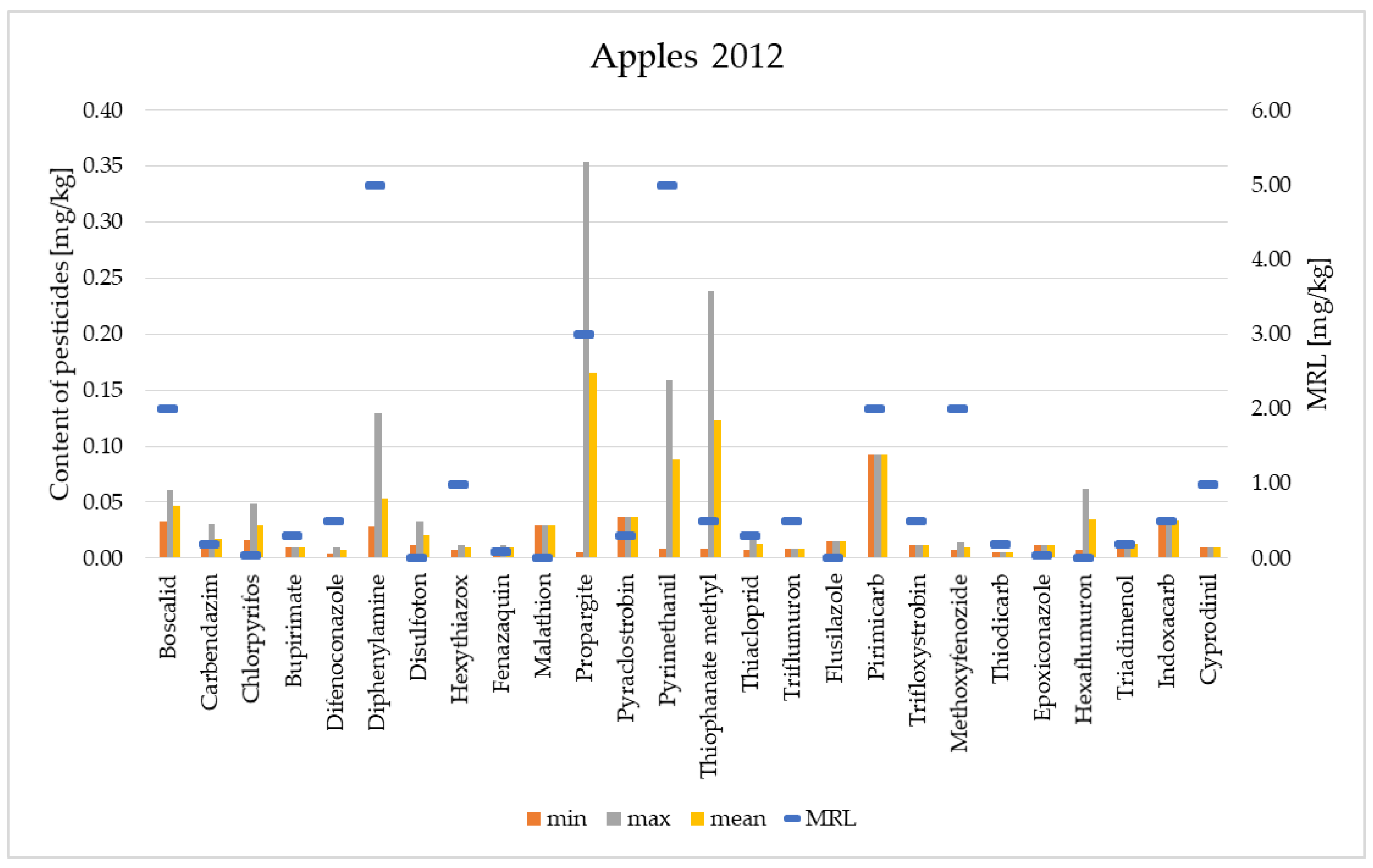

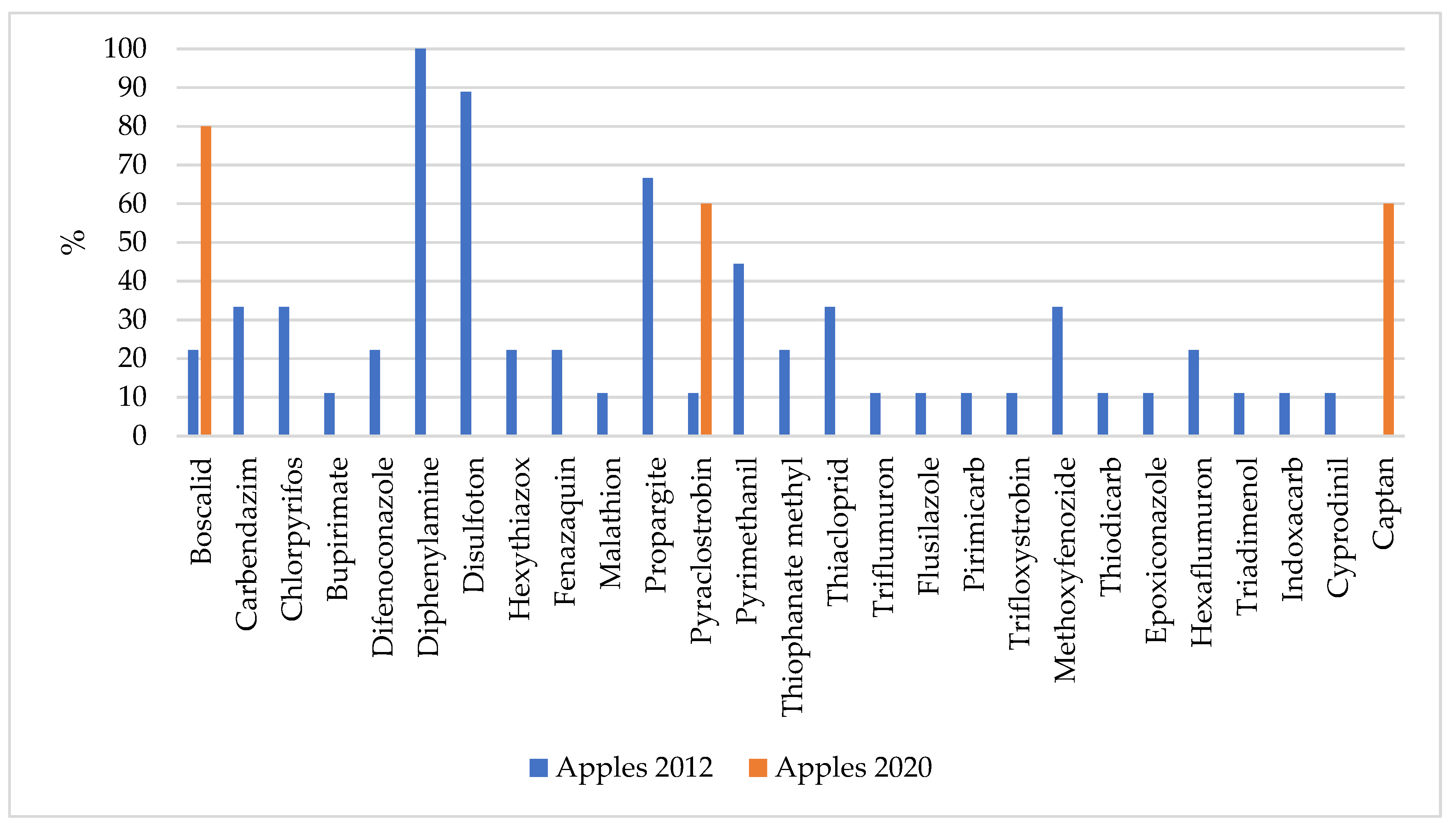
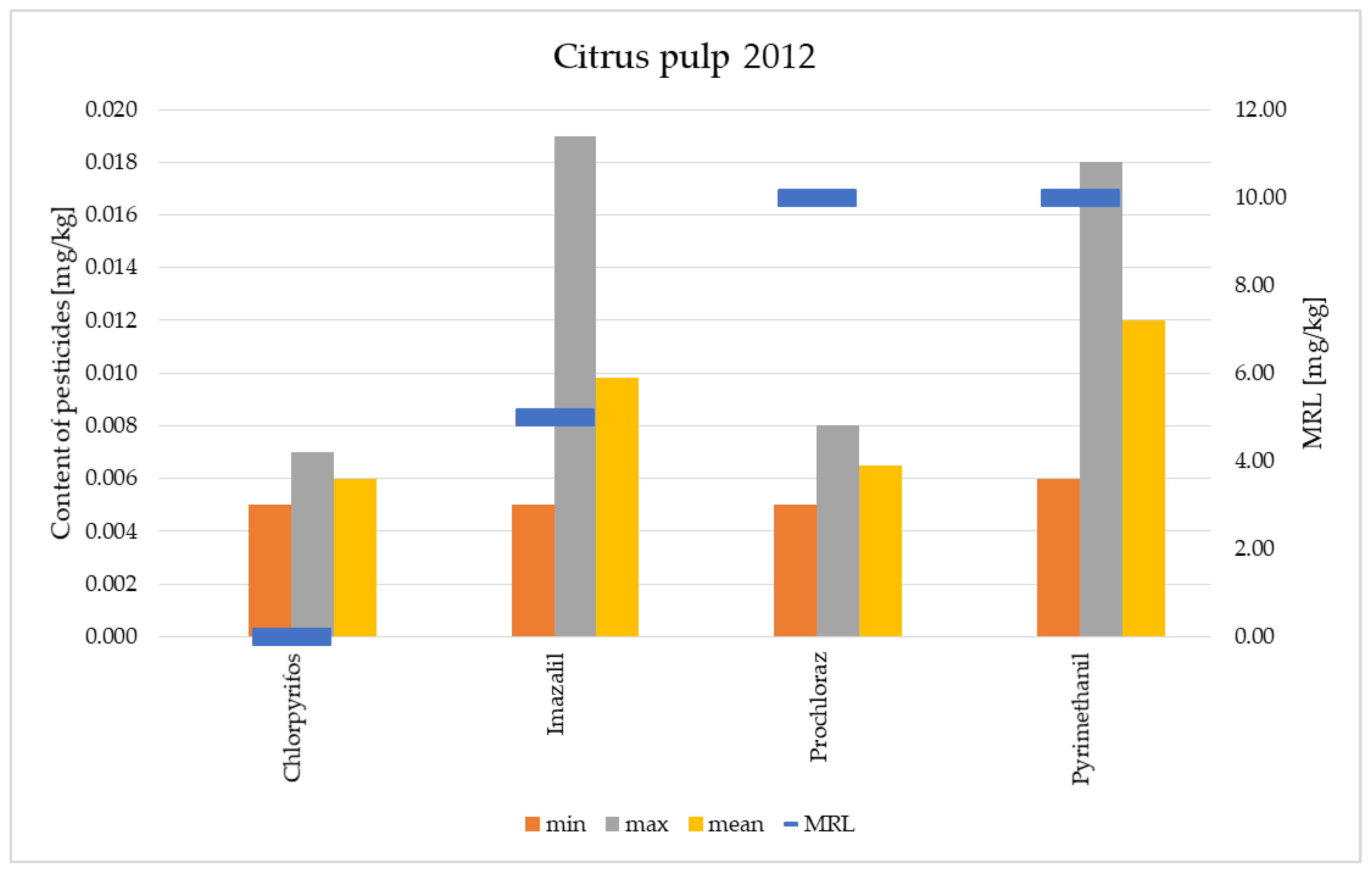


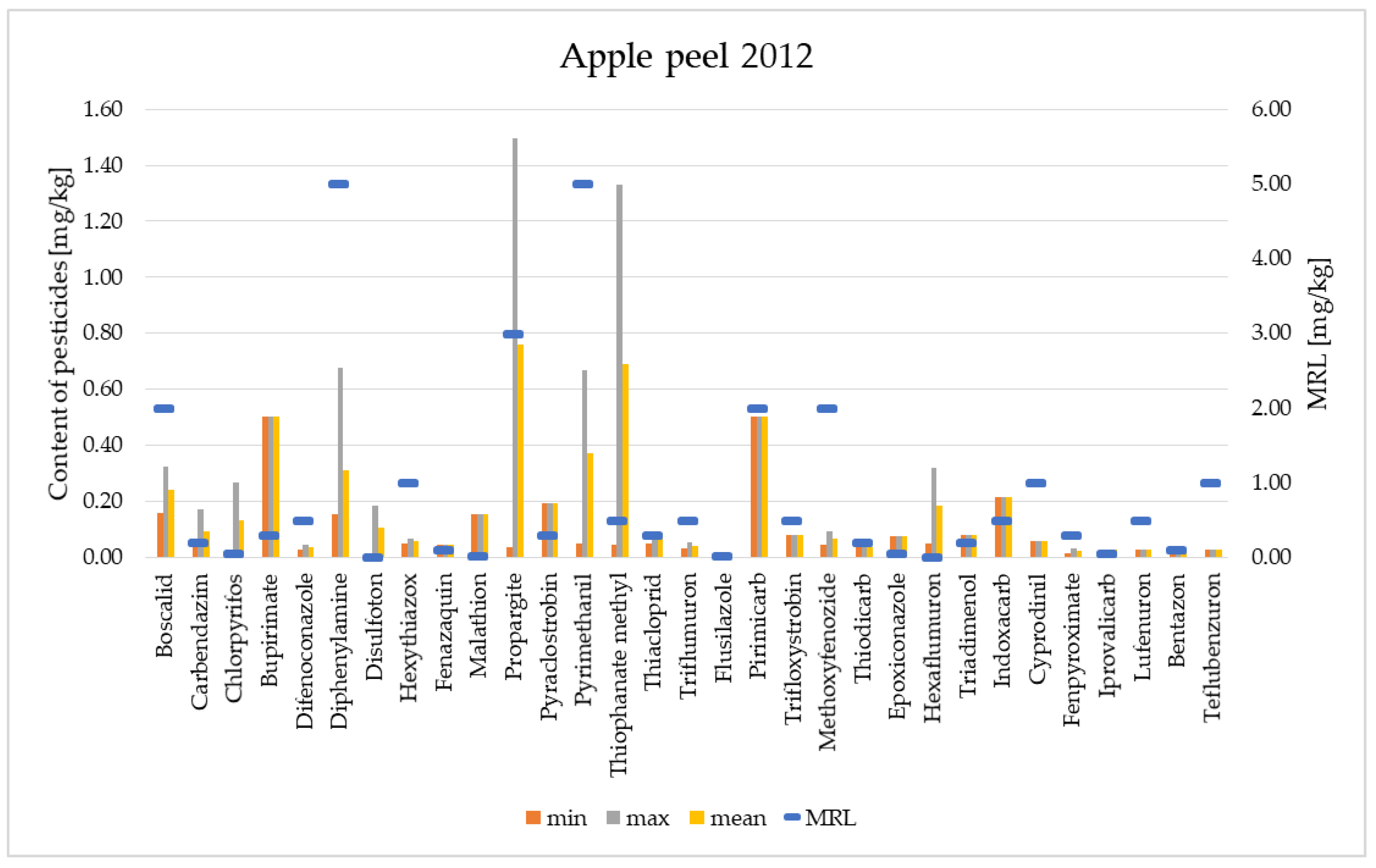
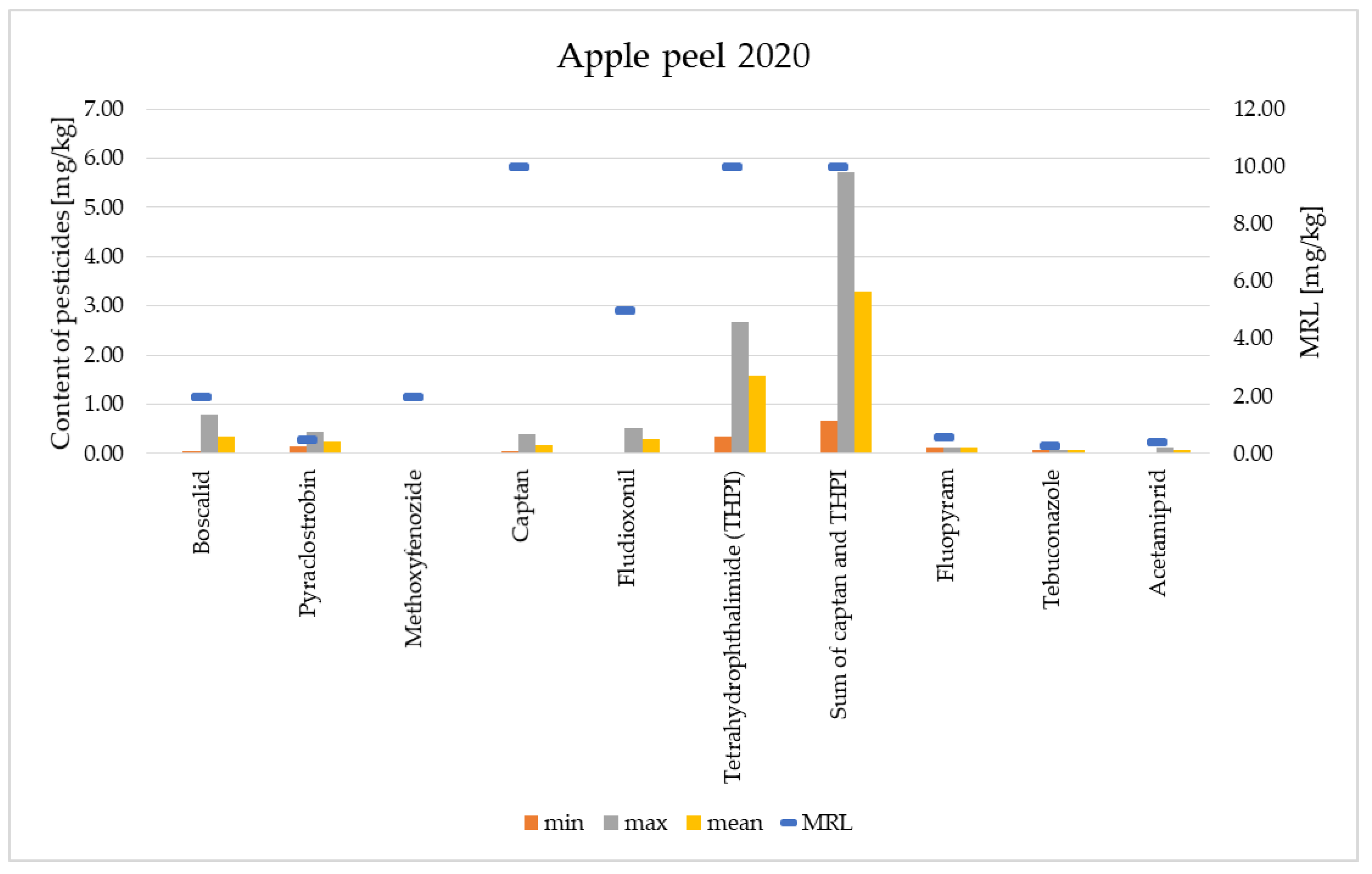
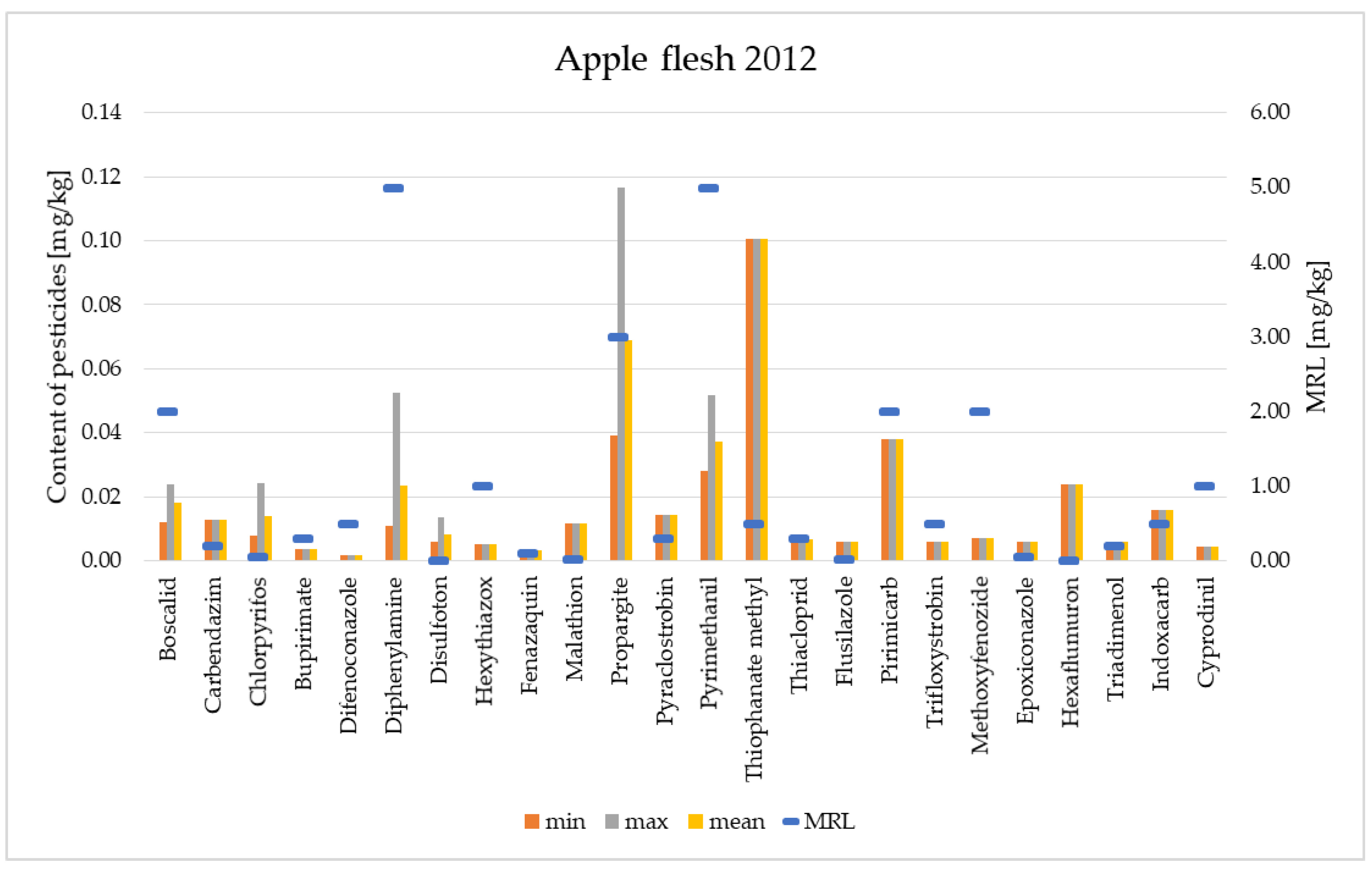

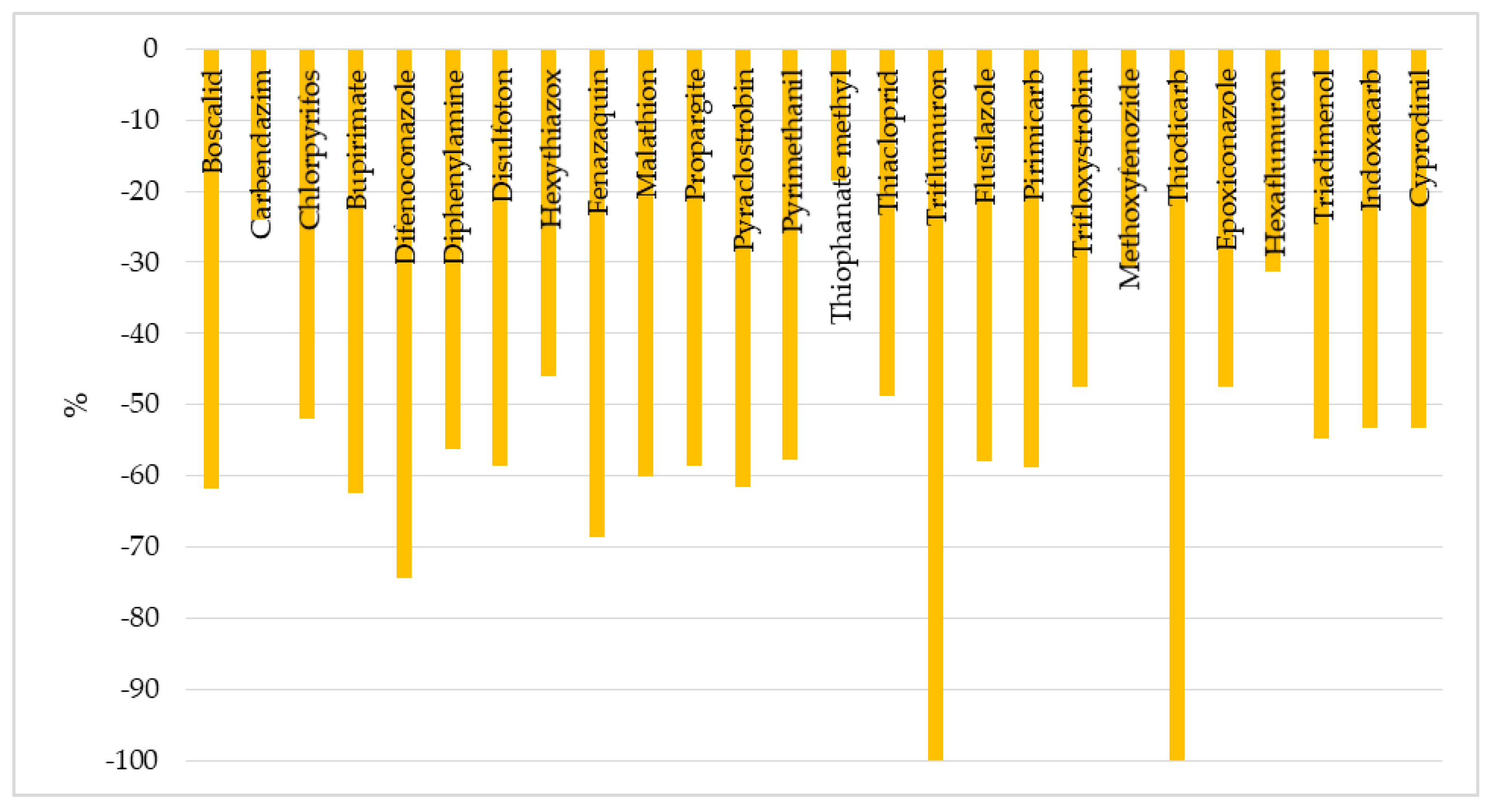
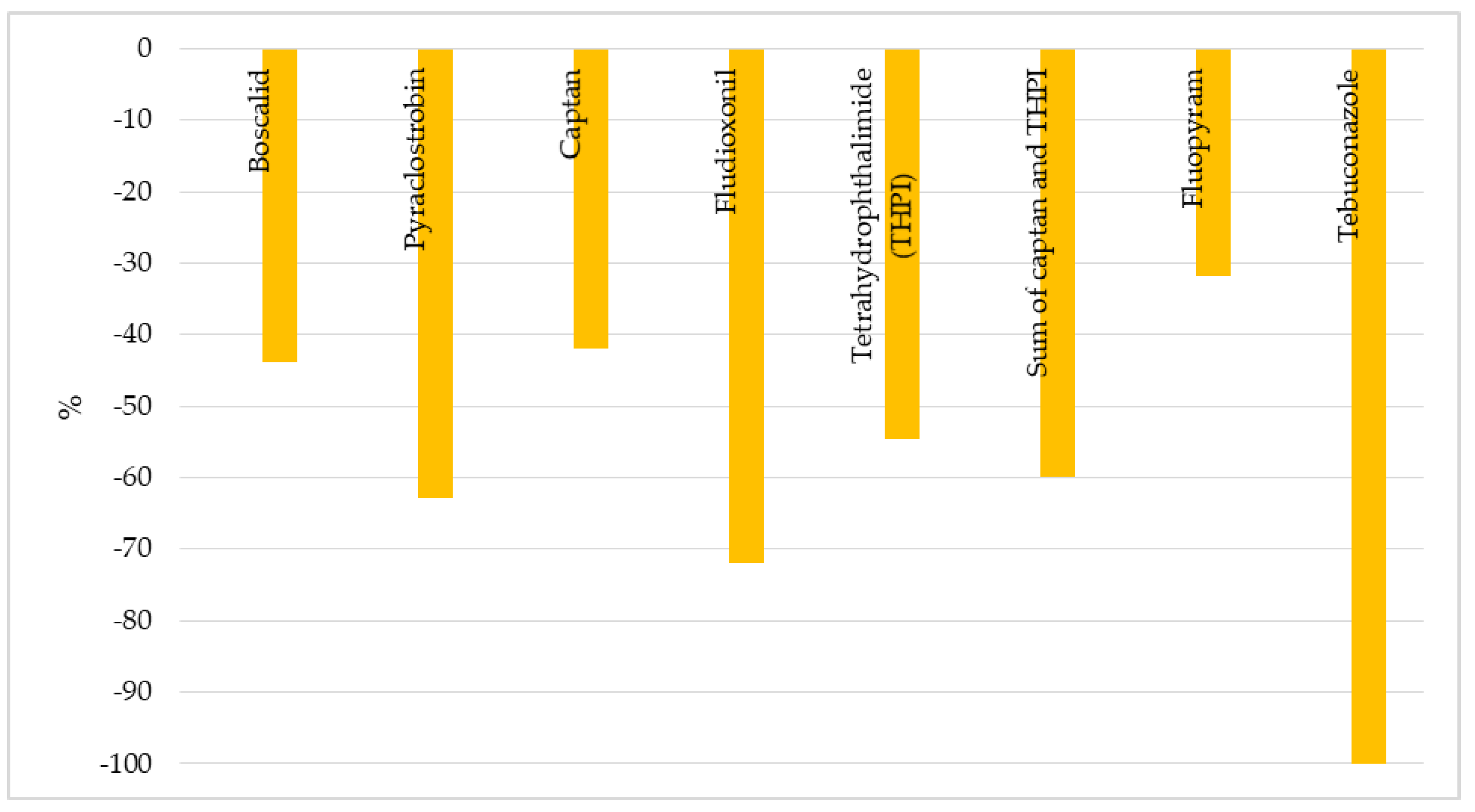
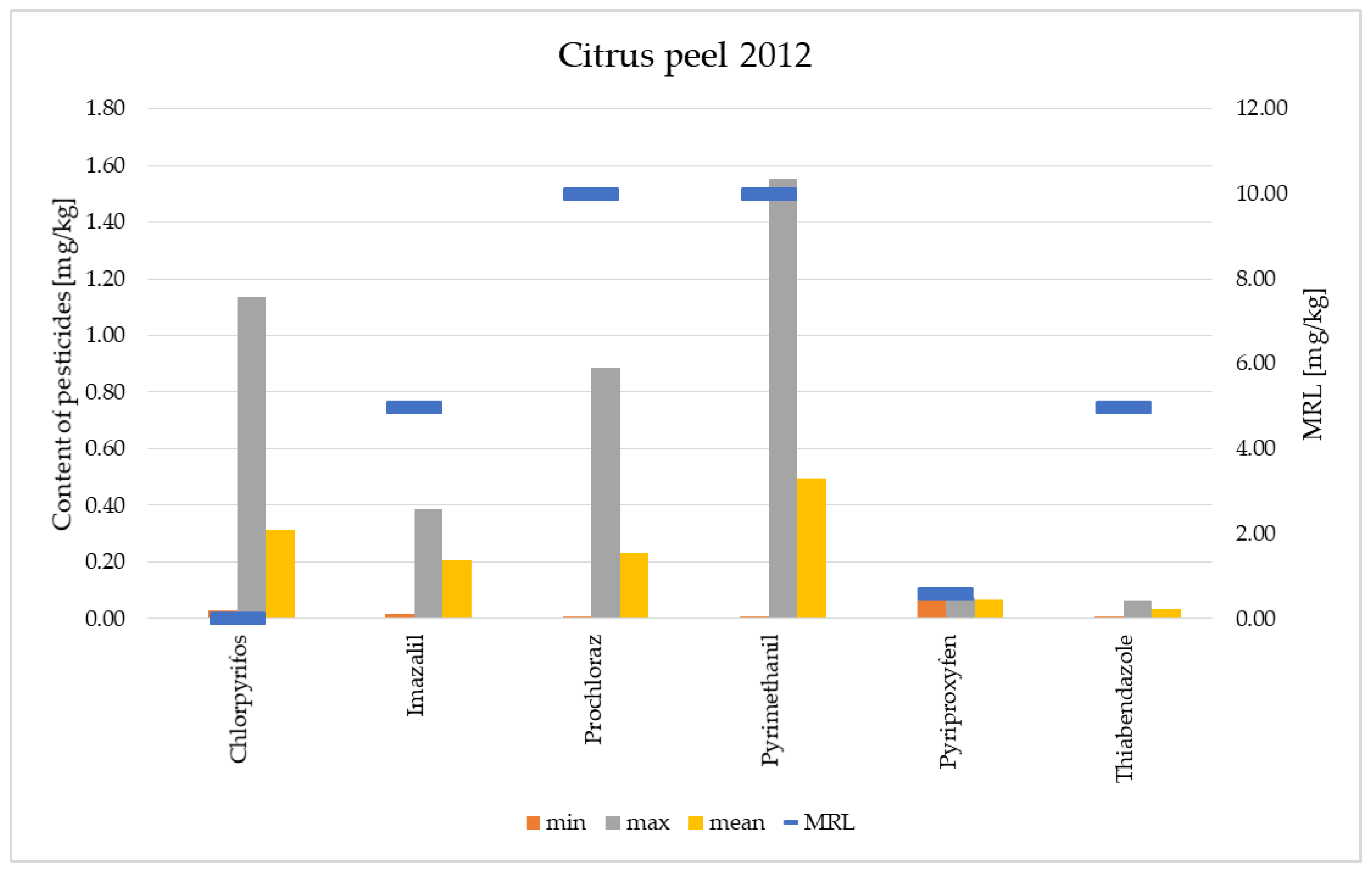

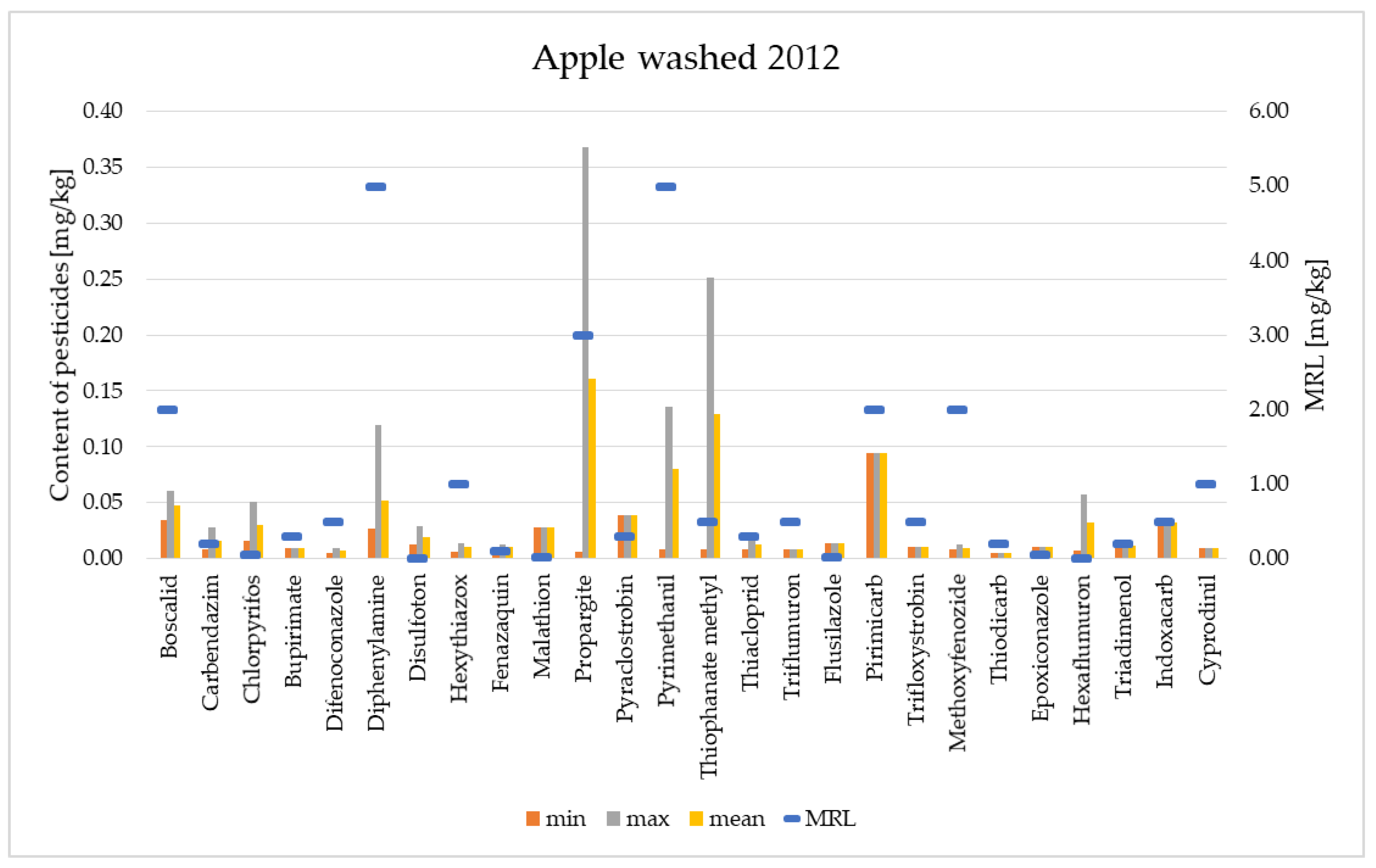
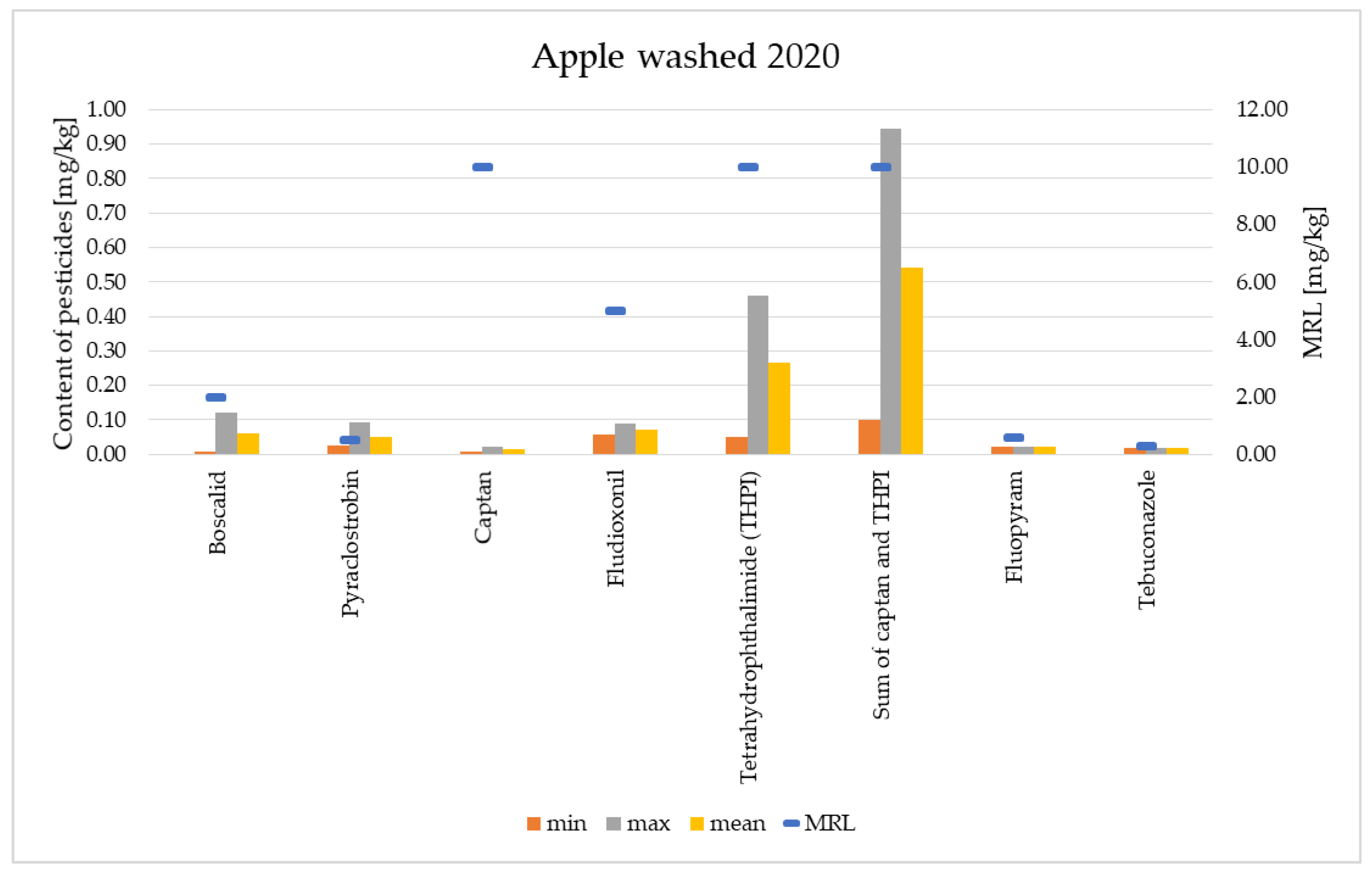
| Pesticide | Group | Range of Pesticides Concentration | MRL | LOQ mg/kg | ||||
|---|---|---|---|---|---|---|---|---|
| Whole Apples | Apple Peels | |||||||
| 2012 | 2020 | 2012 | 2020 | 2012 | 2020 | |||
| boscalid | F | <LOQ–0.0613 d | <LOQ–0.1300 c | <LOQ–0.3245 b | <LOQ–0.7820 a | 2 mg/kg [22] | 2 mg/kg [23] | 0.0005 |
| carbendazim | F | <LOQ–0.0298 b | <LOQ c | <LOQ–0.1691 a | <LOQ c | 0.2 mg/kg [24] | not approved | 0.0001 |
| chlorpyrifos | A, I | <LOQ–0.0490 b | <LOQ c | <LOQ–0.2685 a | <LOQ c | 0.05 mg/kg [25] | not approved 0.01 mg/kg [26] | 0.0001 |
| bupirimate | F | <LOQ–0.0098 b | <LOQ c | <LOQ–0.5000 a | <LOQ c | 0.3 mg/kg | 0.3 mg/kg [27] | 0.0001 |
| difenoconazole | F | <LOQ–0.0096 b | <LOQ c | <LOQ–0.0432 a | <LOQ c | 0.5 mg/kg [28] | 0.8 mg/kg [29] | 0.0002 |
| diphenylamine | PGR | 0.02820–0.130 b | <LOQ c | 0.1536–0.6773 a | <LOQ c | 5 mg/kg [30] | not approved 0.05 mg/kg [31] | 0.025 |
| disulfoton | I | <LOQ–0.0321 b | <LOQ c | <LOQ–0.1858 a | <LOQ c | 0.01 mg/kg [32] | not approved | 0.0001 |
| hexythiazox | A, I | <LOQ–0.0119 b | <LOQ c | <LOQ–0.068 a | <LOQ c | 1 mg/kg [33] | 1 mg/kg [33] | 0.0001 |
| fenazaquin | A | <LOQ–0.0117 b | <LOQ c | <LOQ–0.044 a | <LOQ c | 0.1 mg/kg [34] | 0.1 mg/kg [35] | 0.0005 |
| malathion | A, I | <LOQ–0.0291 b | <LOQ c | <LOQ–0.1534 a | <LOQ c | 0.02 mg/kg [36] | 0.02 mg/kg [37] | 0.0001 |
| propargite | A | <LOQ–0.3540 b | <LOQ c | <LOQ–1.4943 a | <LOQ c | 3 mg/kg [30] | not approved 0.01 mg/kg [38] | 0.0001 |
| pyraclostrobin | F, PGR | <LOQ–0.0370 d | <LOQ–0.087 c | <LOQ–0.1928 b | <LOQ–0.4470 a | 0.3 mg/kg [39] | 0.5 mg/kg [40] | 0.0002 |
| pyrimethanil | F | <LOQ–0.1590 b | <LOQ c | <LOQ–0.6658 a | <LOQ c | 5 mg/kg [39] | 15 mg/kg [38] | 0.0005 |
| thiophanate methyl | F | <LOQ–0.2380 b | <LOQ c | <LOQ–1.3310 a | <LOQ c | 0.5 mg/kg [24] | not approved | 0.0005 |
| thiacloprid | I | <LOQ–0.0161 b | <LOQ c | <LOQ–0.0867 a | <LOQ c | 0.3 mg/kg [41] | not approved 0.3 mg/kg [35] | 0.0001 |
| triflumuron | I | <LOQ–0.0082 b | <LOQ c | <LOQ–0.0508 a | <LOQ c | 0.5 mg/kg [25] | not approved 0.5 mg/kg [42] | 0.0001 |
| flusilazole | F | <LOQ–0.0145 a | <LOQ b | <LOQ–0.0132 a | <LOQ b | 0.02 mg/kg [22] | not approved 0.01 mg/kg [43] | 0.0002 |
| pirimicarb | I | <LOQ–0.092 b | <LOQ c | <LOQ–0.5001 a | <LOQ c | 2 mg/kg [44] | 0.5 mg/kg [45] | 0.0001 |
| trifloxystrobin | F | <LOQ–0.0116 b | <LOQ c | <LOQ–0.0793 a | <LOQ c | 0.5 mg/kg [41] | 0.7 mg/kg [46] | 0.0001 |
| methoxyfenozide | I | <LOQ–0.0136 b | <LOQ c | <LOQ–0.0932 a | <LOQ–0.0190 b | 2 mg/kg [47] | 2 mg/kg [48] | 0.0001 |
| thiodicarb | I | <LOQ–0.0056 b | <LOQ c | <LOQ–0.0346 a | <LOQ c | 0.2 mg/kg [30] | not approved 0.01 mg/kg [49] | 0.0001 |
| epoxiconazole | F | <LOQ–0.0116 b | <LOQ c | <LOQ–0.075 a | <LOQ c | 0.05 mg/kg [39] | not approved | 0.0001 |
| hexaflumuron | I | <LOQ–0.0615 b | <LOQ c | <LOQ–0.321 a | <LOQ c | 0.01 mg/kg [15] | not approved | 0.0001 |
| triadimenol | F | <LOQ–0.0128 b | <LOQ c | <LOQ–0.0791 a | <LOQ c | 0.2 mg/kg [22] | not approved 0.2 mg/kg [50] | 0.001 |
| indoxacarb | I | <LOQ–0.0338 b | <LOQ c | <LOQ–0.2153 a | <LOQ c | 0.5 mg/kg [51] | 0.5 mg/kg [52] | 0.0002 |
| cyprodinil | F | <LOQ–0.0094 b | <LOQ c | <LOQ–0.0588 a | <LOQ c | 1 mg/kg [33] | 2 mg/kg [53] | 0.001 |
| fenpyroximate | A | <LOQ b | <LOQ b | <LOQ–0.0332 a | <LOQ b | 0.3 mg/kg [28] | 0.3 mg/kg [54] | 0.0001 |
| iprovalicarb | F | <LOQ b | <LOQ b | <LOQ–0.0269 a | <LOQ b | 0.05 mg/kg [30] | 0.01 mg/kg [55] | 0.0001 |
| lufenuron | I | <LOQ b | <LOQ b | <LOQ–0.0282 a | <LOQ b | 0.5 mg/kg [30] | not approved 1 mg/kg [54] | 0.0002 |
| bentazon | H | <LOQ b | <LOQ b | <LOQ–0.0311 a | <LOQ b | 0.1 mg/kg [36] | 0.03 mg/kg [40] | 0.001 |
| teflubenzuron | I | <LOQ b | <LOQ b | <LOQ–0.0286 a | <LOQ b | 1 mg/kg [25] | not approved 1 mg/kg [40] | 0.0001 |
| captan | F | - | <LOQ–0.0230 b | - | <LOQ–0.396 a | 3 mg/kg [33] | 10 mg/kg (sum of captan and THPI, expressed as captan) [56] | 0.01 |
| fludioxonil | F | - | <LOQ–0.0970 b | - | <LOQ–0.5300 a | 5 mg/kg [28] | 5 mg/kg [40] | 0.0001 |
| tetrahydrophthalimide (THPI)–captan metabolite | F | - | 0.0530–0.4600 b | - | 0.3360–2.6610 a | 10 mg/kg (sum of captan and THPI, expressed as captan) [56] | 0.01 | |
| fluopyram | F | - | <LOQ–0.0220 b | - | <LOQ–0.1310 a | 0.6 mg/kg [36] | 0.6 mg/kg [46] | 0.01 |
| tebuconazole | F | - | <LOQ–0.0130 b | - | <LOQ–0.081 a | 1 mg/kg [57] | 0.3 mg/kg [58] | 0.0001 |
| acetamiprid | I | - | <LOQ b | - | <LOQ–0.128 a | 0.7 mg/kg [39] | 0.4 mg/kg [59] | 0.0001 |
| Pesticide | Group | Range of Pesticides Concentration | MRL | LOQ mg/kg | ||||
|---|---|---|---|---|---|---|---|---|
| Citrus Pulp | Citrus Peels | |||||||
| 2012 | 2020 | 2012 | 2020 | 2012 | 2020 | |||
| chlorpyrifos | A, I | <LOQ–0.0070 c | <LOQ d | 0.0300–1.1350 a | <LOQ–0.1380 b | 0.01 mg/kg [25] | not approved 0.01 mg/kg [26] | 0.0001 |
| imazalil | F | 0.0050–0.0190 c | 0.0050–0.0210 c | 0.0160–0.3860 b | 0.4320–1.10 a | 5mg/kg [44] | grapefruits and oranges 4 mg/kg lemons 5 mg/kg [54] | 0.0005 |
| prochloraz | F | <LOQ–0.0080 b | <LOQ c | <LOQ–0.8840 a | <LOQ c | 10 mg/kg [51] | 0.03 mg/kg [88] | 0.0002 |
| pyrimethanil | F | <LOQ–0.0180 c | <LOQ–0.0180 c | 0.0090–1.5550 b | 0.0100–1.8000 a | 10 mg/kg [39] | 8 mg/kg [38] | 0.0005 |
| pyriproxyfen | I | <LOQ b | <LOQ b | <LOQ–0.0720 a | <LOQ b | 0.6 mg/kg [25] | 0.6 mg/kg [54] | 0.0001 |
| thiabendazole | F | <LOQ b | <LOQ b | <LOQ–0.0640 a | <LOQ b | 5 mg/kg [30] | 7 mg/kg [89] | 0.0001 |
| spirotetramat-enol spirotetramat-enol-glucoside | F | - - | <LOQ–0.0330 a <LOQ–0.0290 a | - - | <LOQ b 0.0090–0.0240 a | 0.5 mg/kg [90] 1 mg/kg (expressed as spirotetramat) [56] | 0.01 | |
| acetamiprid | I | - | <LOQ b | - | <LOQ–0.0170 a | 1 mg/kg [39] | 0.9 mg/kg [59] | 0.0001 |
| hexythiazox | A, I | - | <LOQ b | - | <LOQ–0.0110 a | 1 mg/kg [33] | 1 mg/kg [33] | 0.0001 |
Publisher’s Note: MDPI stays neutral with regard to jurisdictional claims in published maps and institutional affiliations. |
© 2022 by the authors. Licensee MDPI, Basel, Switzerland. This article is an open access article distributed under the terms and conditions of the Creative Commons Attribution (CC BY) license (https://creativecommons.org/licenses/by/4.0/).
Share and Cite
Kowalska, G.; Pankiewicz, U.; Kowalski, R. Assessment of Pesticide Content in Apples and Selected Citrus Fruits Subjected to Simple Culinary Processing. Appl. Sci. 2022, 12, 1417. https://doi.org/10.3390/app12031417
Kowalska G, Pankiewicz U, Kowalski R. Assessment of Pesticide Content in Apples and Selected Citrus Fruits Subjected to Simple Culinary Processing. Applied Sciences. 2022; 12(3):1417. https://doi.org/10.3390/app12031417
Chicago/Turabian StyleKowalska, Grażyna, Urszula Pankiewicz, and Radosław Kowalski. 2022. "Assessment of Pesticide Content in Apples and Selected Citrus Fruits Subjected to Simple Culinary Processing" Applied Sciences 12, no. 3: 1417. https://doi.org/10.3390/app12031417
APA StyleKowalska, G., Pankiewicz, U., & Kowalski, R. (2022). Assessment of Pesticide Content in Apples and Selected Citrus Fruits Subjected to Simple Culinary Processing. Applied Sciences, 12(3), 1417. https://doi.org/10.3390/app12031417







